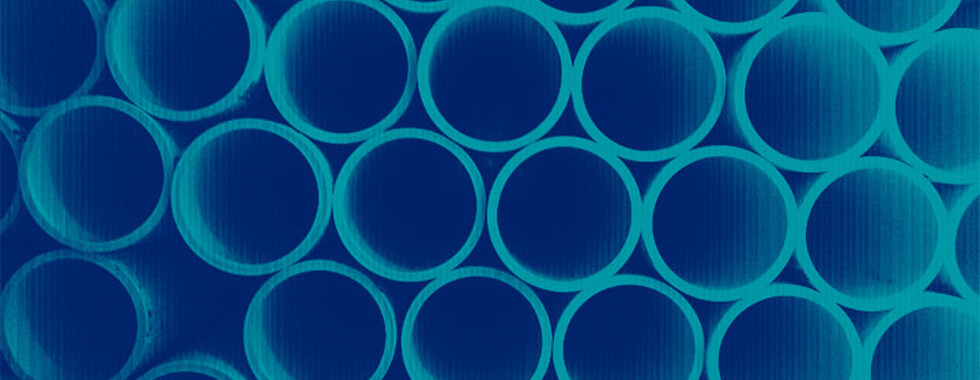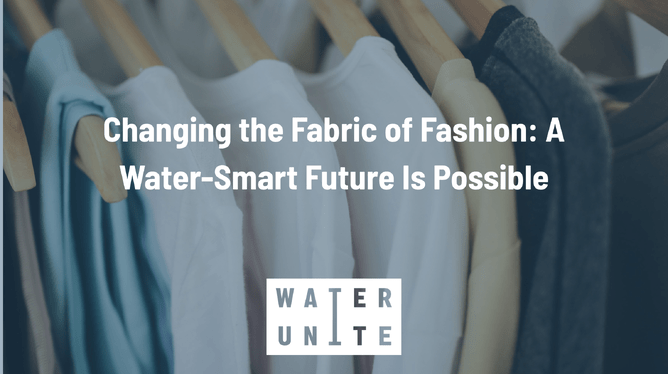With new fashion trends emerging weekly and fashion serving as a form of self-expression, there's constant pressure to buy and consume more clothing. However, this rapid pace of consumption is placing a significant strain on water. The growing demand highlights an urgent need to examine the environmental consequences of the fashion industry, particularly how both consumer habits and manufacturing practices contribute to the problem. Fortunately, solutions are taking shape, with innovation in the industry and growing consumer awareness offering a path toward a more responsible future.
The Weight of Style: Fashion’s Strain on Water
Fashion is undeniably a water-intensive industry, consuming enough water each year to fill approximately 37 million olympic-sized swimming pools (Oxfam, 2024). Cotton, the most used fabric in clothing, demands especially high water usage, relying heavily on irrigation and depleting valuable groundwater resources. But the impact of fashion goes far beyond sheer water consumption (Bandera, 2024).
The Global South bears the burden of the fashion industry’s consequences, with countries like Bangladesh, Cambodia and China being among the most affected. While manufacturers cut costs and consumers benefit from cheap clothing, inadequate waste management in many countries threatens local communities and ecosystems. In Bangladesh, garment factories consume around 1,500 billion liters of water annually, depleting groundwater and polluting local waterways (Bandera, 2024). What’s more, it is estimated that 75% of apparel and textile sites will face high to extreme water risks by 2050 (Gora, 2024), particularly in high risk regions such as India, China, Brazil and Pakistan.
While cotton places significant stress on water resources, synthetic fabrics like polyester and nylon, which now make up around 70% of all clothing, present their own environmental risks (Geneva Environment Network, 2025). Producing these materials requires approximately 70 million barrels of oil each year (Cho, 2021). In addition, synthetic garments shed microfibers, commonly known as microplastics, which account for about 35% of the plastic pollution found in the ocean.
Further, approximately only 15% of all textiles are recycled, either through downcycling or international shipment (Lundberg and Devoy, 2022). Secondhand clothing donated from countries like the UK, US, and China is often sold to markets like Kantamanto in Accra, Ghana, one of the world’s largest used clothing hubs (Johnson, 2023). While once profitable, vendors now find much of the clothing unusable, low-quality and damaged. Around 40% of these garments become waste, overwhelming local communities (Marc, 2023). Consequently, most end up burned, dumped in informal landfills, or in places like Old Fadama, a densely populated region in Accra, Ghana, buried in clothing waste and environmental degradation.
The consequences of fashion go beyond environmental degradation; they pose serious threats to the livelihoods and health of the local population. In the south of Weija, the internationally recognized Densu Delta Ramsar wetlands and a crucial breeding ground for endangered species, have been affected by runoff from nearby dumpsites. This pollution threatens key livelihoods such as oyster farming, carried out by local women, and fishing in the mangrove spawning grounds. Residents who live in or near toxic dumps also rely on these contaminated water sources (Greenpeace , 2024).
How Consumers, Manufacturers, and Policymakers Can Drive Change
We can no longer overlook the impact of fashion on water as it continues to place immense strain on both people and the planet. Creating change is no longer optional, it’s essential. But meaningful progress doesn’t come from individuals alone; it comes from collective action and a shared vision for the future.
Fortunately, some companies are taking a step forward by recognising the crucial role of water. Levis Strauss is also one of the brands that has toughened its strategy, following a five year review of its emissions targets. Their 2025 Water Action Strategy outlines a comprehensive plan to reduce the company’s water footprint across its supply chain (Levi Strauss & Co, 2024). They have shifted towards context-based water targets, meaning that water saving-efforts are tailored to the specific stress level of local watersheds. Another crucial component of the strategy is their Water<Less® program created in 2011. One of the core intentions is to evolve the Water program from a process-based approach into a facility-level qualification (Levi Strauss & Co, 2024). This means a supplier can now qualify as a Water<Less® facility by meeting water reduction targets that are based on local water stress. Additionally, they will be setting intermediate targets to help suppliers track their progress. If suppliers meet these milestones, they’ll be considered a Water<Less® facility with all products made in those facilities being sold with that label.
Levis & Strauss also approaches water stewardship through the materials they source. One of their initiatives includes the use of cottonised hemp, a fiber innovation that offers a more sustainable alternative to conventional cotton. Cottonised hemp is less water intensive and can rely on rainwater instead of irrigated water (Sabaghi, 2021). This innovative solution is only part of the company’s broader effort to scale sustainable materials and reduce environmental impacts.
Gap Inc is also taking a creative approach to water stewardship by becoming the first apparel company to join an initiative aimed at combating water waste through AI. Partnering with UK-based Fido Tech, Gap Inc is supporting projects in Bengaluru, India to detect and reduce underground water pipeline leaks across 350km (Gap Inc, 2025). Using advanced AI technology which analyses acoustic data to rand and identify hidden leaks, Gap Inc is improving water efficiency for overstretched utilities. This marks FIDO’s first project in India after successfully implementing them in the UK, US and Mexico with support from other major corporations such as Microsoft, Meta and Coca Cola.
Kering, a luxury company, is also one of the latest to identify the need for responsible corporate water stewardship. In April 2025, they unveiled their first dedicated water strategy for a net positive impact by 2050. Rather than just reducing consumption, Kering commits to actively restoring water cycles and ecosystems through the lens of a Climate-Nature-Water nexus. Their three programmes include: Water-positive stewardship Program, Water-Positive Materials and Water Resilience Labs. For Kering, being water positive goes far beyond reduction to actively restore water cycles and ecosystems through systemic change and a Climate-Nature-Water nexus and people-centric approach (Kering, 2025).
Home to many of the group’s tanneries and supplier tanneries, the Arno Basin in Tuscany is a key water source for Kering. As a core focus of Kering’s Water-Positive Strategy, it serves as the pilot site for their Water Resilience Labs. Due to its high water stress, pollution, and industrial activity, the Arno Basin faces significant environmental challenges. According to studies (Hofste et al., 2019), the region is facing the highest possible water availability risk, along with severe ecosystem degradation. In response, Kering is launching targeted interventions in the area to reduce water withdrawals by 21%, a goal validated by the Science-Based Targets for Nature (Kering, 2025).
Making better decisions as consumers
Consumers also play a significant role in driving change through their purchasing decisions. By choosing to support higher-quality, sustainable products, they have the power to push the industry toward a more environmentally conscious future. Among the many brands making strides in this direction, No Nasties stands out as a pioneer and model for sustainable fashion. Like many smaller brands nowadays, they have embedded sustainability across the entire value chain, from offering full transparency, using ethically sourced materials, and eliminating plastic from packaging. They source lower-impact materials such as organic cotton to reduce harmful chemicals, water usage and wastewater.
Additionally, a report from Oxfam revealed that “the water needed to make one pair of jeans would meet the daily drinking needs of 4,750 people”, a striking example of the social and environmental consequences these products can have. They urge consumers to embrace a more circular economy by adopting practices such as repairing, reusing, redistributing, upcycling, and recycling. Choosing to buy second-hand clothing is another effective step toward reducing carbon emissions and easing the environmental burden of new garment production (Oxfam GB, 2024).
Looking ahead: a water-smart future is possible
The water and fashion sectors are deeply intertwined in ways that are often overlooked. At Water Unite, this intersection is reflected by our 5 core investment pillars, going beyond traditional WASH (Water, Sanitation & Hygiene) programmes. We support scalable, water-secure solutions ranging from water preservation to plastic and wastewater circularity.
This can be illustrated in the case of Gree Energy, transforming agricultural runoff into valuable resources in Indonesia. Others such as Pack2Zero are providing a biodegradable alternative to traditional single-use plastic packaging. Spanning across sectors, the Water Unite Impact team has identified an extensive pipeline of innovations driving water security globally. Examples include:
Scalable leather processing methods which significantly reduces water use and CO2 emissions.
Revolutionary textile dying processors which leverages bio-technology to avoid the use of harmful chemicals whilst reducing water, waste and energy usage.
Reusable, single-use plastic alternatives for clothing and household goods.
Bio-based startups providing low impact, cost-effective leather alternatives through the provision of agricultural waste and mushroom mycelium.
At Water Unite, we’re committed to scaling our impact by partnering with innovators and changemakers addressing water insecurity across industries. If you are interested in collaborating with Water Unite please reach out at mediarelations@waterunite.org
References
Bandera, G. (2024, April 25). How the fashion industry pollutes our water. FairPlanet. https://www.fairplanet.org/story/how-the-fashion-industry-pollutes-our-water/
Cho, R. (2021, June 10). Why Fashion Needs to Be More Sustainable. State of the Planet; Columbia Climate School. https://news.climate.columbia.edu/2021/06/10/why-fashion-needs-to-be-more-sustainable/
Gap Inc. (2025). Gap Inc. and FIDO AI Collaborate to Improve Water Resilience in Supply Chain Communities | Gap Inc. Gap Inc. https://www.gapinc.com/en-us/articles/2025/06/gap-inc-and-fido-ai-collaborate-to-improve-water-r
Geneva Environment Network. (2025, May 23). Environmental Sustainability in the Fashion Industry. Geneva Environment Network. https://www.genevaenvironmentnetwork.org/resources/updates/sustainable-fashion/
Gora, A. (2024, March 22). Is Fashion’s Impact on Water being overlooked? Read more here! Global Fashion Agenda. https://globalfashionagenda.org/news-article/is-fashions-impact-on-water-being-overlooked/
Greenpeace . (2024). greenpeace.org Acknowledgements. https://www.greenpeace.org/static/planet4-africa-stateless/2024/09/925601ff-fastfashionslowpoison_reportbygreenpeace.pdf
Grundy, D. (2024, September 21). Fast fashion: Oxfam urges people to buy second-hand jeans. BBC News; BBC News. https://www.bbc.co.uk/news/articles/cpqz9qy7y14o
Johnson, S. (2023, June 5). “It’s like a death pit”: how Ghana became fast fashion’s dumping ground. The Guardian. https://www.theguardian.com/global-development/2023/jun/05/yvette-yaa-konadu-tetteh-how-ghana-became-fast-fashions-dumping-ground
Kering. (2025, April 28). Kering unveils its first dedicated water strategy for a net positive impact by 2050. Kering.com; Kering. https://www.kering.com/en/news/kering-unveils-its-first-dedicated-water-strategy-for-a-net-positive-impact-by-2050/
Levi Strauss & Co. (2024). Water Stewardship. Levi Strauss & Co. https://www.levistrauss.com/sustainability-report/climate/water-stewardship/
Lundberg, D., & Devoy, J. (2022, September 22). The Aftermath of Fast Fashion: How Discarded Clothes Impact Public Health and the Environment | SPH. Www.bu.edu; Boston University School of Public Health. https://www.bu.edu/sph/news/articles/2022/the-aftermath-of-fast-fashion-how-discarded-clothes-impact-public-health-and-the-environment/
Marc, J. (2023, August 10). At one of the world’s largest secondhand textile markets, discarded clothes are getting a new lease on life. CNN. https://edition.cnn.com/2023/08/10/africa/kantamanto-textile-market-ghana-or-foundation-spc-intl/index.html?utm_source=chatgpt.com
Oxfam. (2024, September 2). Oxfam GB | Buying one pair of second-hand jeans and a t-shirt could save equivalent of 20,000 bottles of water - Oxfam. Oxfam GB. https://www.oxfam.org.uk/media/press-releases/buying-one-pair-of-second-hand-jeans-and-a-t-shirt-could-save-equivalent-of-20000-bottles-of-water-oxfam/
Oxfam GB. (2024, October 8). The water cost of fast fashion. Oxfam GB. https://www.oxfam.org.uk/oxfam-in-action/oxfam-blog/the-water-cost-of-fast-fashion-a-crisis-of-climate-change-inequality-what-we-can-do-about-it/
Sabaghi, D. (2021, October 12). Levi’s Aims To Use More Hemp For Its Fashion Collections. Forbes. https://www.forbes.com/sites/dariosabaghi/2021/10/12/levis-jeans-company-aims-to-use-more-hemp-for-its-fashion-collections/

